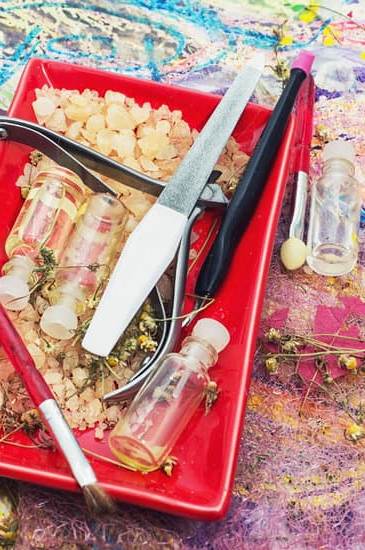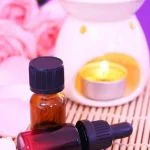An aromatherapy eye pillow is a small cushion specifically designed to provide comfort and relaxation for the eyes. It is typically made with soft fabric and filled with ingredients like dried herbs, rice, flaxseeds, or lavender buds. In addition to its soothing qualities, an aromatherapy eye pillow also incorporates essential oils to enhance its therapeutic benefits.
The benefits of using an aromatherapy eye pillow are numerous. Firstly, the gentle pressure applied by the pillow helps promote relaxation and relieve tension in the eye area. This can be especially beneficial for individuals who spend long hours in front of screens or suffer from eye strain.
Additionally, the filling options such as dried herbs or lavender buds release pleasant scents that can have a calming effect on the mind and body. The use of essential oils further enhances these benefits by providing additional aromatherapeutic properties.
Making your own aromatherapy eye pillow allows you to customize it according to your preferences and needs. Whether you are looking for relaxation, headache relief, or better sleep, there are various filling options and essential oils that can be incorporated into your homemade eye pillow to address specific concerns.
In the following sections, we will explore how to make an aromatherapy eye pillow step-by-step, discuss different filling options and essential oil combinations, share tips for selecting suitable fabrics for the pillow case, answer frequently asked questions surrounding this topic, as well as provide bonus variations for specific needs. So let’s dive in and learn how to create a blissful accessory that will bring comfort and tranquility to your daily life.
Materials needed for making an aromatherapy eye pillow
To make an aromatherapy eye pillow, you will need a few materials to ensure its effectiveness and durability. Here is a list of essential materials needed for making an aromatherapy eye pillow:
- Fabric: Choose a soft, lightweight, and breathable fabric for the eye pillow case. Cotton or linen are excellent choices as they feel gentle against the skin and allow for airflow.
- Thread: Select a sturdy thread that matches the color of your fabric. This will help ensure that the eye pillow holds up well after being filled and used.
- Sewing machine or needle and thread: Depending on your sewing abilities, you can use either a sewing machine or hand sew the eye pillow case. A sewing machine will make the process quicker and more efficient.
- Scissors: Have a pair of fabric scissors on hand to cut out the desired shape and size of your eye pillow case.
- Pins or clips: Use pins or clips to secure the fabric together before sewing. This will prevent any shifting while you stitch the pieces together.
- Measuring tape or ruler: Accurate measurements are crucial for creating a well-fitting eye pillow case. A measuring tape or ruler will help you achieve precise dimensions.
- Iron: An iron is necessary for pressing your fabric before cutting and after sewing to create crisp edges and a professional finish.
By gathering all these materials, you’ll be ready to move on to the next step in creating your own aromatherapy eye pillow – sewing the case itself.
Step-by-step instructions for sewing the eye pillow case
To create an aromatherapy eye pillow, you will need to sew a case to hold the filling. Follow these step-by-step instructions to make your own eye pillow case:
- Begin by selecting the fabric for your eye pillow case. Choose a soft and breathable material such as cotton or linen. Cut two identical rectangles of fabric, each measuring approximately 10 inches by 4 inches.
- Place the two fabric rectangles together with their right sides facing inwards. Pin them together along three sides, leaving one of the shorter ends open. This will be where you insert the filling later on.
- Using a sewing machine or needle and thread, sew along the pinned edges with a 1/4-inch seam allowance. Reinforce the corners by backstitching at the beginning and end of each side.
- Once all three sides are sewn, turn the fabric right side out through the open end. Use a pencil or chopstick to gently push out the corners, ensuring they are well-defined.
- Now it’s time to add a closure for your eye pillow case. Fold and press about 1/4 inch of fabric towards the inside on both ends of the open side of the case.
- Fold over an additional 1 inch of fabric on each end and press again. Pin in place and sew along both edges, creating a neat hemmed closure for your eye pillow case.
- Finally, it’s time to fill your eye pillow with your desired filling material such as dried herbs, rice, flaxseeds, or lavender buds (as outlined in section 4). Pour in enough filling so that the pillow is comfortably weighted but still allows for flexibility and molding around your eyes.
- Once filled, fold over the open end of your eye pillow case and use pins or hand-stitching to close it securely.
Congratulations. You have successfully sewn an eye pillow case. Now you can enjoy the benefits of aromatherapy and relaxation by using your customized eye pillow.
| Materials Needed |
|---|
| – Fabric (cotton or linen) |
| – Sewing machine or needle and thread |
| – Pins |
| – Scissors |
| – Ruler or measuring tape |
Filling options for the eye pillow
When it comes to filling your aromatherapy eye pillow, there are several options to choose from. Each filling option offers its own unique benefits and characteristics that enhance the overall experience of using an eye pillow. Here are some popular options for filling your eye pillow:
- Dried Herbs: Herbs such as chamomile, lavender, rosemary, or peppermint can be used to fill your eye pillow. These herbs have soothing properties and can promote relaxation and stress relief.
- Rice: Rice is a common filling option for eye pillows due to its ability to hold both heat and cold temperatures well. Just pop the eye pillow in the microwave or freezer for a few seconds or minutes, depending on your preference, and enjoy the therapeutic benefits of heat or cold therapy.
- Flaxseeds: Flaxseeds are another great option for filling your eye pillow. They offer a gentle pressure that helps alleviate tension around the eyes and promote relaxation. Additionally, flaxseeds retain heat well, making them ideal for heat therapy when heated in the microwave.
- Lavender Buds: If you’re looking to incorporate a calming scent into your aromatherapy eye pillow, lavender buds are an excellent choice. Known for their relaxing properties, lavender buds can help induce a sense of calmness and improve sleep quality.
When selecting a filling option for your eye pillow, consider your personal preferences and desired benefits. Experiment with different fillings to find the one that works best for you.
Tips
- Make sure to use organic dried herbs or food-grade grains when choosing fillings.
- Be mindful of any allergies or sensitivities you may have before selecting a filling option.
- If using dried herbs as fillings, ensure they are properly dried beforehand to prevent mold or spoilage.
- Remember to adjust the amount of filling based on your preferred weight and pressure level.
By selecting the right filling option for your aromatherapy eye pillow, you can tailor the experience to meet your specific needs and enhance the benefits of relaxation and stress relief. Get creative and experiment with different fillings to find your perfect combination.
As always, seek guidance from a healthcare professional or aromatherapist if you have any concerns or questions about using certain fillings in your eye pillow, especially if you have underlying health conditions or are pregnant.
Incorporating essential oils into the eye pillow for added aromatherapy benefits
One way to enhance the benefits of an aromatherapy eye pillow is to incorporate essential oils into the filling. Essential oils are highly concentrated plant extracts that can provide a range of therapeutic effects. By choosing the right essential oil, you can customize your eye pillow to target specific needs such as relaxation, stress relief, or headache relief.
Before adding essential oils to your eye pillow, it’s important to choose oils that are safe for use around the eyes. Some options that are generally considered safe include lavender, chamomile, and peppermint. Lavender is known for its calming properties and can promote relaxation and sleep. Chamomile has anti-inflammatory effects and may help relieve headaches and tension. Peppermint has a cooling effect and can provide relief from sinus congestion or headaches.
To incorporate essential oils into your eye pillow, there are a few different methods you can try. One option is to add a few drops of the chosen essential oil directly onto the filling material before sewing up the eye pillow case.
Alternatively, you could place a few drops of essential oil onto a cotton ball or pad and place it inside the eye pillow case before sewing it closed. This allows for easier customization because you can easily swap out the cotton pad with a different oil if desired.
It’s important to note that some individuals may have sensitivities or allergies to certain essential oils. If you’re new to using essential oils or have any concerns about potential reactions, it’s always best to do a patch test on your skin before incorporating them into your eye pillow. Additionally, be sure not to overdo it with the quantity of essential oil used as they are highly concentrated substances.
| Essential Oil | Benefits |
|---|---|
| Lavender | Promotes relaxation and sleep |
| Chamomile | Relieves headaches and tension |
| Peppermint | Provides relief from sinus congestion or headaches |
Tips and tricks for selecting the right fabric for the eye pillow case
When it comes to selecting the right fabric for your aromatherapy eye pillow case, there are a few tips and tricks that can help ensure you make the best choice. The fabric you choose will not only affect the durability and quality of your eye pillow, but also the overall sensory experience and comfort.
- Softness and Texture: One of the key factors to consider when choosing fabric for your eye pillow is its softness and texture. Look for fabrics that are gentle against the skin, such as lightweight cotton or satin. These materials will not only feel soothing on your eyes, but they will also minimize any irritation or discomfort.
- Breathability: It’s important to choose a fabric that is breathable to avoid excessive sweating or discomfort when using the eye pillow. Fabrics like organic cotton or linen are great options as they allow air circulation, preventing moisture build-up and promoting a more comfortable experience.
- Hypoallergenic Properties: If you have sensitive skin or allergies, it’s important to select a fabric that is hypoallergenic. Fabrics such as bamboo cotton or silk are known for their hypoallergenic properties, making them a suitable choice for those with sensitivities.
- Durability: Since your eye pillow will be used regularly, it’s crucial to choose a fabric that is durable enough to withstand repeated use and washing. Look for fabrics that have a tight weave and good tensile strength, such as canvas or upholstery-weight cotton, which are more resilient over time.
- Aesthetics: While functionality is key in selecting the right fabric for your eye pillow case, aesthetics shouldn’t be overlooked either. Choose a fabric color or pattern that brings you joy and relaxation when using your eye pillow. Consider soothing colors like blues or neutrals, or calming patterns like floral designs.
By considering these tips and tricks when selecting the right fabric for your aromatherapy eye pillow case, you can create a comfortable, durable, and aesthetically pleasing accessory that enhances your relaxation experience. Take the time to explore different options and feel the fabric for yourself before making a selection. Remember, the right fabric can make all the difference in your aromatherapy eye pillow journey.
Bonus section
Eye pillows are not only a great way to relax and de-stress, but they can also be tailored to specific needs for maximum benefits. By adding different ingredients and essential oils, you can create variations of eye pillows that are specifically designed to provide relaxation, headache relief, or enhance sleep. Here are some variations to consider:
- Relaxation Eye Pillow: For those moments when you just need to unwind and let go of stress, a relaxation eye pillow is the perfect companion. Fill the pillow with dried herbs such as lavender, chamomile, and rose petals. These herbs have calming properties that can help promote relaxation and reduce anxiety.
- Headache Relief Eye Pillow: If you suffer from headaches or migraines, an eye pillow can provide soothing relief. Fill the pillow with flaxseeds or rice, which have a weighty yet malleable texture that conforms to the contours of your face and provides gentle pressure on your temples. Add a few drops of peppermint or eucalyptus essential oil for their analgesic properties.
- Sleep Enhancement Eye Pillow: For those struggling with insomnia or other sleep issues, a sleep enhancement eye pillow can create a calming atmosphere and promote better sleep quality. Filling options like dried lavender buds can help induce feelings of calmness and relaxation. Incorporate essential oils like lavender or chamomile for their sedative effects.
Remember to always test the essential oils on your skin before incorporating them into your eye pillow to ensure you’re not allergic or sensitive to them. It’s also important to keep in mind that everyone’s preferences may vary, so feel free to experiment with different combinations until you find what works best for you.
Tips for Usage
- Before using an eye pillow variation for the first time, take a moment to inhale deeply and familiarize yourself with its scent.
- Find a comfortable position either lying down or sitting up, and gently place the eye pillow over your closed eyes.
- Allow yourself to breathe deeply and relax, focusing on the scent and sensations of the eye pillow.
- Use your eye pillow in a quiet and calm environment to optimize its benefits.
Maintenance
To maintain the freshness and effectiveness of your eye pillow, store it in a cool, dry place when not in use. If your eye pillow is removable, you can wash the cover when needed according to its fabric instructions. It’s recommended to replace the filling every 6-12 months or as needed to ensure that it stays fresh and retains its aroma.
By creating variations of eye pillows based on specific needs, you can enhance your aromatherapy experience and reap even greater benefits. Whether you’re seeking relaxation, headache relief, or improved sleep quality, these variations can provide targeted support for your well-being. Experiment with different combinations of fillings and essential oils until you find what works best for you.
Frequently asked questions about aromatherapy eye pillows and their answers
As you embark on your journey of making your own aromatherapy eye pillow, you may have some lingering questions about the process or the benefits. Here, we answer some frequently asked questions to provide you with a better understanding and ensure success in creating your customized eye pillow.
- Q: How long do the aromatherapy effects last once the eye pillow is filled?
- A: The duration of aromatherapy effects varies depending on the filling and essential oils used. Dried herbs, rice, flaxseeds, or lavender buds can retain their aroma for several weeks to a few months. However, it’s important to note that over time, the scent may gradually fade.
- Q: Can I heat or cool my aromatherapy eye pillow?
- A: Yes. Depending on your needs and preferences, you can heat or cool your eye pillow for added relief. For warm therapy, microwave the filled eye pillow for around 20-30 seconds before use, making sure to test the temperature before placing it on your eyes. To cool it down, place the filled eye pillow in a sealable plastic bag and refrigerate for at least an hour.
- Q: How often should I replace the filling of my eye pillow?
- A: It is recommended to replace the filling every 6-12 months to ensure optimal freshness and efficacy. Lavender buds tend to lose their scent more quickly compared to other fillings; therefore, they may need more regular replacement.
- Q: Can I wash my aromatherapy eye pillow?
- A: The outer casing of most eye pillows can be removed and washed. However, it’s essential to check the fabric care instructions beforehand to prevent any damage. If you are uncertain about washing a particular fabric, spot cleaning is a safe alternative.
By addressing these common queries about aromatherapy eye pillows, we hope that you feel confident and knowledgeable as you embark on this DIY project. Remember to have fun, experiment with different fillings and scents, and enjoy the soothing benefits of your homemade eye pillow. Good luck.
Frequently Asked Questions
What is the best filling for eye pillows?
The best filling for eye pillows is typically a combination of flaxseed and dried lavender flowers. Flaxseeds provide a gentle pressure that helps to relieve tension around the eyes, while the lavender flowers add a soothing and calming scent.
Together, this combination creates a perfect blend of weight and aroma that promotes relaxation and aids in relieving headaches or stress. Additionally, the flaxseed filling can be easily molded to fit the contours of the face, providing optimal comfort.
What is the best fabric for eye pillow?
When it comes to choosing the best fabric for an eye pillow, it is important to prioritize comfort and breathability. One popular fabric option is 100% cotton, as it is soft against the skin and allows for proper airflow. The natural fibers of cotton also help prevent overheating, making it an ideal choice especially when using the eye pillow during relaxation or sleep.
Silk satin is another luxurious option known for its smoothness and hypoallergenic properties. Ultimately, selecting a fabric that feels gentle on your skin and enhances your overall sensory experience will make for a more enjoyable use of the eye pillow.
How do you make aromatherapy pillows?
Creating aromatherapy pillows involves combining essential oils with either dried herbs or organic materials such as flaxseeds or rice that act as carriers for the fragrance. To make these pillows, begin by selecting your desired combination of essential oils based on their therapeutic properties and personal preference.
It’s important to choose high-quality oils diluted with a carrier oil to avoid any irritation on sensitive skin areas like around the eyes. Next, mix these essential oils with dried herbs or seeds in a bowl until well-distributed throughout the material.

Are you looking for a natural way to improve your health and wellbeing?
If so, aromatherapy may be the answer for you.





